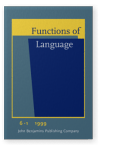Vol. 6:1 (1999) ► pp.53–94
Definitions in English technical discourse
A study in metafunctional dominance and interaction
This paper explores degrees of equivalence constructed in English technical definitions. From an ergative perspective, the degree of equivalence depends upon the effectiveness of the clause (i.e. effective vs middle). Effective clauses tend to be encoding in orientation (i.e. the direction of the coding in the clause is from the gloss to the term) whereas middle clauses tend to be decoding (from term to gloss) (Halliday 1967/8, 1994; Davidse 1992a, 1996). In technical definitions, ideational meaning (expressed in relational clauses) is typically metafunctionally dominant and lexicogrammatically "deautomatized" (Mukarovsky 1977), while interpersonal meanings (expressed in mood and modality) are less dominant and "automatized". In technical definitions, the source of knowledge is either absent but probeable or absent and non-probeable. It is argued here that, despite the general automatization of interpersonal meaning in definitional clauses, a residue of interpersonality is in fact critical to the degree of equivalence constructed in the clause.
Cited by
Cited by 6 other publications
This list is based on CrossRef data as of 2 july 2024. Please note that it may not be complete. Sources presented here have been supplied by the respective publishers. Any errors therein should be reported to them.
